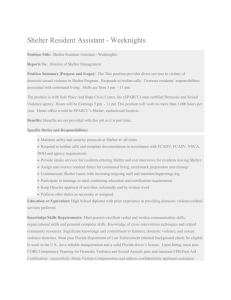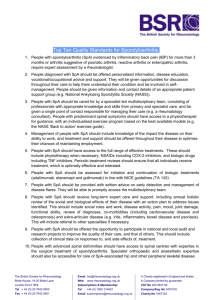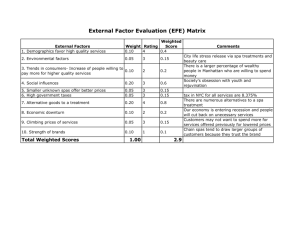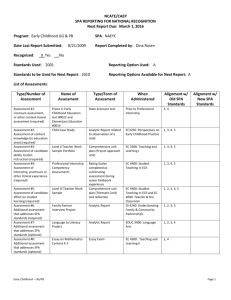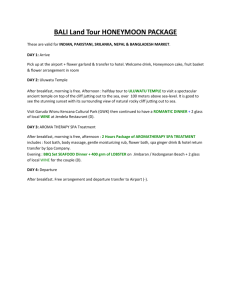Annual updates: SpA and PsA SPARCC
advertisement
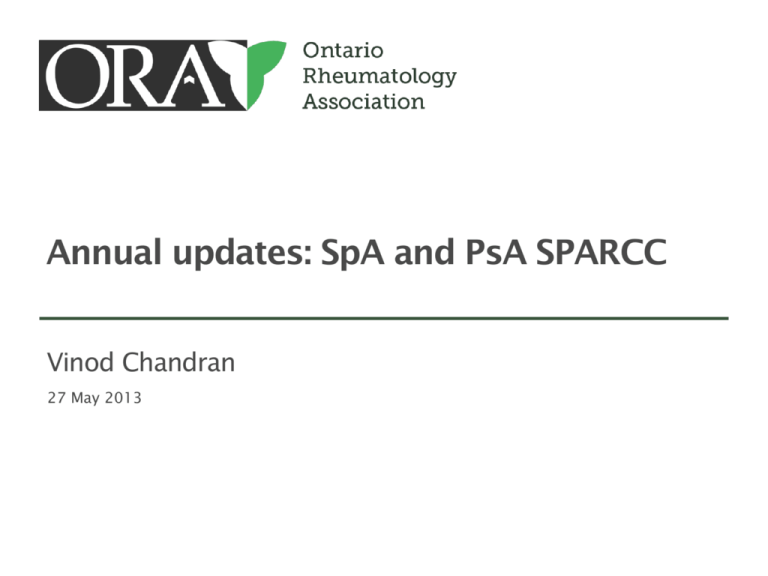
Annual updates: SpA and PsA SPARCC Vinod Chandran 27 May 2013 Learning Objectives • To understand the utility of a spondyloarthritis database • Review results of studies conducted using the database 2 Disclosures • Honoraria: • Abbott/Abbvie, Amgen, Bristol-Myers Squibb, Celgene, Janssen, Pfizer • Advisory Board: • Abbott/Abbvie, Amgen, Celgene, Janssen, Pfizer • Research Grants: • Abbvie Spondyloarthritis A group of inflammatory rheumatic diseases with the following common features: • • • • • • peripheral as well as axial arthritis radiological sacroiliitis mucosal and skin inflammation tendency for familial aggregation absence of rheumatoid factors absence of subcutaneous nodules Ann Rheum Dis 2011;70:1-3. A trans-disciplinary national research program focusing on Genetic and Pathogenesis Studies and Outcome Measures for Patients with SpA Established 2003 Funded by The Arthritis Society National Research Initiative Grant 2006-2010 The SPARCC Executive Committee SPARCC Objectives Overall Objective • To improve the health of SpA patients in Canada by better defining, diagnosing, and predicting the course of AS and PsA The three objectives and key elements of the SPARCC research network are • Improved understanding of the biological basis of SpA • Improved clinical outcomes in SpA • Improved assessment of the impact of SpA in Canada. SPARCC Research Areas of focus •Cohort expansion and detailed longitudinal follow up •Identification and validation of biomarkers •Development of personalized treatments •Development of strategies for early detection •Development of tools and techniques for best practices for clinicians SPARCC Achievements •Advances in • • Genetics and Outcome Measures Unique Populations • • • • • juvenile SpA First Nations population Access to Care Social Role Participation measuring the impact of SpA on quality of life Knowledge Transfer and Exchange •Establishment of a common clinical database •Partnership with the Canadian Spondylitis Association (CSA) SPARCC Database Site AS PsA nXR ReA USpA Total Toronto 657 1257 40 27 128 2109 St. John’s 233 528 0 0 0 761 Edmonton 836 0 0 0 0 836 Montreal 54 76 0 2 11 143 Winnipeg 39 0 0 0 0 39 Saskatoon 14 13 1 4 3 35 London 46 50 0 0 0 96 Newmarket 53 12 11 0 0 76 1932 1936 52 33 142 4095 Total AS=ankylosing spondylitis; PsA=psoriatic arthritis; nXR=non-radiographic AS; ReA=reactive arthritis; USpA=undifferentiated Spondyloarthritis. SPARCC Database Demographics Disease No. Age Dx F/M(%) % Caucasian % HLA-B27+ AS 1096 31.2 28 / 72 87 80.7 PsA 1933 37.9 46 / 54 89 43.5 nXR 52 33.7 60 / 40 92 56.3 ReA 33 35.8 45 / 55 91 73.5 USpA 142 29.9 38 / 62 85 60.1 SPARCC Database Extra-articular features at 1st Visit Disease % Uveitis % Ps vulgaris PASI % Nail AS 6.1 5.3 0.9 8.7 PsA 0.4 78.0 5.4 63.5 nXR 0 7.3 4.4 8.6 ReA 3.2 8.7 0.4 5.9 0 2.9 0.2 2.5 USpA SPARCC Database Co-morbid conditions Disease % Cardiac % Diabetes % Cancer % Trauma % Infection AS 19.1 2.9 2.4 13.8 16.0 PsA 36.9 8.2 5.9 15.1 17.2 nXR 17.0 3.8 1.9 12.2 15.7 ReA 15.0 2.5 0 6.3 63.9 USpA 15.4 3.7 2.5 5.6 20.4 SPARCC Database Medication Use 1st Visit Disease % NSAIDs % DMARDs % Biologics AS 71 27 26 PsA 79 55 11 nXR 77 15 13 ReA 51 40 10 USpA 60 30 12 SPARCC Achievements Advances in Genetics • AS • IL-1 gene cluster, IL-23R, and ERAP-1 • Functional implications of ERAP1 • GWAS and meta-analysis underway • Immunochip analysis with IGAS consortium • CNV analysis • UGT2B17 gene CNV • Exome sequencing • PsA • HLA-Cw6/MICA/TNF-α/KIR alleles, IL-1 gene cluster, IL-23R • GWAS and meta-analysis underway • ReA • TLR2 Ann Rheum Dis 2008;67:1305-9. Arthritis Rheum 2008;58:1020-5. Arthritis Rheum 2009;60:1317-23. Ann Rheum Dis 2010;69:297-300. J Rheumatol 2009;36:137-40. Arthritis Rheum 2008;58:3436-8. SPARCC Achievements Advances in Biomarkers • Multiplex assay of a panel of 58 biomarkers in AS: • identification of high priority candidates for prediction of structural damage • Osteocalcin and RANTES higher in AS • Progressor subgroup: • MMP-9, TGFα, TNFα elevated • Non-progressor subgroup: • eotaxin, IFNα-2, and MCP-3 elevated Arthritis Rheum 63(10suppl):S644, 2011. SPARCC Achievements Advances in Outcome Measures • INSPIRE study • MRI • SPARCC MRI scoring system • Impact • Social Role Participation Questionnaire • Work Instability J Rheumatol 2007;34:1740-5. J Rheumatol 2007;34:1733-9. Arthritis Rheum2007;57:501-7. Ann Rheum Dis 2011;70:1765-9. Arthritis Rheum 2012;64(Suppl 10):S 595-6 SPARCC Achievements Advances in Unique Populations • Paediatric Populations • Validation of outcome measures used in adult SpA in Juvenile SpA • Whole-body MRI • First Nations • Access to effective therapeutics amongst SpA patients from the First Nations peoples in British Columbia SPARCC Achievements Advances in Access to Care & Guidelines of SPARCC/CRA • The CRA/SPARCC Treatment Recommendations for the Management of Spondyloarthritis: A National Multidisciplinary Stakeholder Project J Rheumatol 2007;34:2273-84. SPARCC Achievements Advances in Knowledge Transfer and Exchange • Handbook for physicians entitled • Ankylosing Spondylitis: Assessment Scores, Classification and Diagnostic Criteria • Public Symposia on SpA in collaboration with the Canadian Spondylitis Association • Web videos (sparcc.ca ) • Spinal mobility measurements • Video archive of all the public patient fora • Annual Fellows training day Future Direction • Longitudinal changes in SpA • • predictors for progression of joint damage Compare differences among SpA over time Compare quality of life and function among different SpA Comparison amongst different regions of Canada Gender effect on disease progression Drug Response Economic impact Co-morbidities Imaging Access to Care Predictive profiles of radiographic progression: Serum biomarker analysis • SpA in children (novel markers for prognosis and activity) • SpA in First Nations (prevalence, genetic susceptibility, care gaps) • • • • • • • • • Summary • Spondyloarthritis not well studied in North America • SPARCC developed to address need • SPARCC has made important new observations in SpA and has a significant international profile • SPARCC will continue to further research, advocacy and education in SpA
